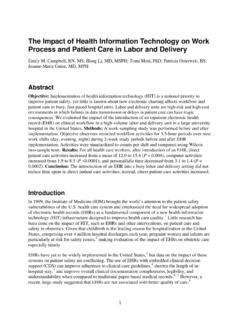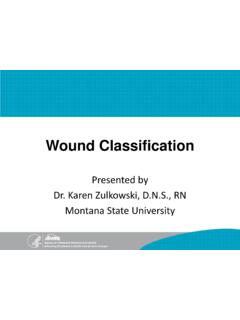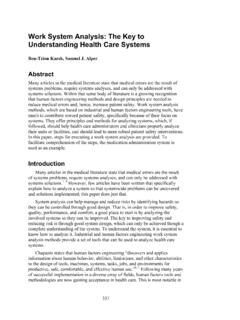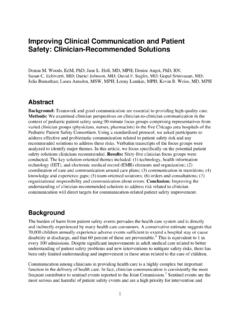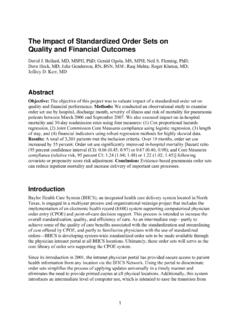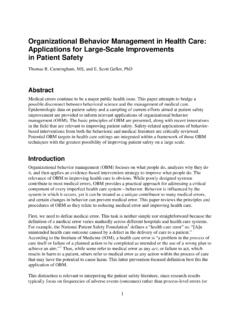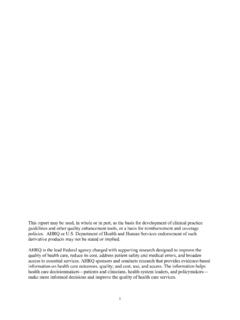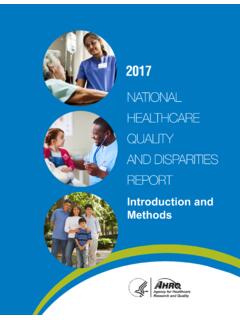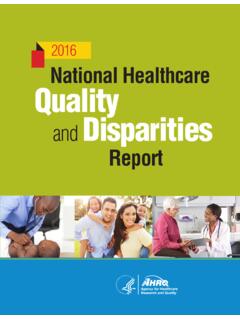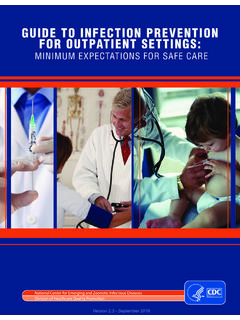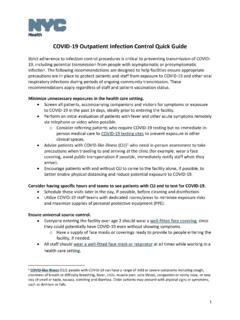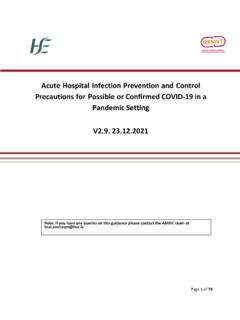Transcription of AHRQ Quality Indicators
1 AHRQ Quality IndicatorsGuide to prevention Quality Indicators :Hospital Admission forAmbulatory Care Sensitive ConditionsDepartment of Health and Human ServicesAgency for Healthcare Research and 2001 AHRQ Pub. No. 02-R0203 Revision 1 (April 17, 2002)CitationAHRQ Quality Indicators Guide to prevention Quality Indicators : Hospital Admissionfor Ambulatory Care Sensitive Conditions. Rockville, MD: Agency for HealthcareResearch and Quality , 2001. AHRQ Pub. No. programs for the prevention Quality Indicators (PQIs) can be downloaded Instructions on how to use the programs to calculate the PQIrates are contained in the companion text, prevention Quality Indicators : health care as in other arenas, that which cannot be measured is difficult to improve. Providers, consumers, policy makers, and others seeking to improve the Quality of health careneed accessible, reliable Indicators of Quality that they can use to flag potential problems, followtrends over time, and identify disparities across regions, communities, and providers.
2 As notedin a 2001 Institute of Medicine study, Envisioning the National Health Care Quality Report, it isimportant that such measures cover not just acute care but multiple dimensions of care: stayinghealthy, getting better, living with illness or disability, and coping with the end of Agency for Healthcare Research and Quality (AHRQ) Quality Indicators (QIs) areone Agency response to this need for a multidimensional, accessible family of Quality include a family of measures that providers, policy makers, and researchers can use withinpatient data to identify apparent variations in the Quality of either inpatient or outpatient s Evidence-Based Practice Center (EPC) at the University of California San Francisco(UCSF) and Stanford University adapted, expanded, and refined these Indicators based on theoriginal Healthcare Cost and Utilization Project (HCUP) Quality Indicators developed in the early1990s.
3 The new AHRQ QIs are organized into three modules: prevention Quality Indicators ,Inpatient Quality Indicators , and Patient Safety Indicators . During 2001 and 2002, AHRQ will bepublishing the three modules as a series. Full technical information on the first two modules canbe found in Evidence Report for Refinement of the HCUP Quality Indicators , prepared by theUCSF-Stanford EPC. It can be accessed at AHRQ s Web site at This first module focuses on preventive care services outpatient services geared tostaying healthy and living with illness. Researchers and policy makers have agreed for sometime that inpatient data offer a useful window on the Quality of preventive care in the community. Inpatient data provide information on admissions for ambulatory care sensitive conditions thatevidence suggests could have been avoided, at least in part, through better outpatient , community leaders, and policy makers can then use such data to identify communityneed levels, target resources, and track the impact of programmatic and policy interventions.
4 One of the most important ways we can improve the Quality of health care in America isto reduce the need for some of that care by providing appropriate, high- Quality preventiveservices. For this to happen, however, we need to be able to track not only the level ofoutpatient services but also the outcome of the services people do or do not receive. This guideis intended to facilitate such efforts. As always, we would appreciate hearing from those whouse our measures and tools so that we can identify how they are used, how they can be refined,and how we can measure and improve the Quality of the tools themselves. Irene Fraser, , DirectorCenter for Organization and Delivery Studies iiAcknowledgmentsThis product is based on the work of many individuals who contributed to itsdevelopment and following staff from the Evidence-based Practice Center (EPC) at UCSF-Stanfordperformed the evidence review, completed the empirical evaluation, and created theprogramming code and technical documentation for the new Quality Indicators : Core Project Team Mark McClellan, , , principal investigator Jeffrey Geppert, Kathryn M.
5 McDonald, , EPC coordinator Patrick Romano, , Sheryl M. Davies, Kaveh G. Shojania, Other ContributorsAmber Barnato, McCoy, Collins, Olson, Duncan LaShawndra Pace, Gould, , Schleinitz, Heidenreich, Szeto, Haberland, Vorhaus, Matz, Weiss, Maclean, Wheat, Martins, Staiger, following staff from Social & Scientific Systems, Inc., developed this software product,documentation, and guide:ProgrammersTechnical WriterLeif KarellPatricia CaldwellKathy McMillanGraphics DesignerLaura SpoffordContributors from the Agency for Healthcare Research and Quality :Anne Elixhauser, Joanna Jiang, Coopey, , , also wish to acknowledge the contribution of the peer reviewers of the evidencereport and the beta-testers of the software products, whose input was of iiIntroduction to the AHRQ prevention Quality 1 What Are the prevention Quality Indicators ?
6 1 How Can the PQIs be Used in Quality Assessment?.. 2 What does this Guide Contain?.. 3 Origins and Background of the Quality 4 Development of the AHRQ Quality 4 AHRQ Quality Indicator 5 Methods of Identifying, Selecting, and Evaluating the Quality 6 Summary Evidence on the prevention Quality 12 Strengths and Limitations in Using the 16 Questions for Future 17 Detailed Evidence for prevention Quality 19 Bacterial Pneumonia Admission 21 Dehydration Admission 23 Pediatric Gastroenteritis Admission 25 Urinary Tract Infection Admission 27 Perforated Appendix Admission 29 Low Birth Weight 31 Angina without Procedure Admission 33 Congestive Heart Failure Admission 35 Hypertension Admission 37 Adult Asthma Admission 39 Pediatric Asthma Admission 41 Chronic Obstructive Pulmonary Disease Admission 43 Uncontrolled Diabetes Admission 45 Diabetes Short-Term Complications Admission 47 Diabetes Long-Term Complications Admission 49 Rate of Lower-Extremity Amputation among Patients with 53 Appendix A: prevention Quality Indicator DefinitionsAppendix B.
7 Detailed Methods 1 Introduction to the AHRQ prevention Quality IndicatorsPrevention is an important role for all health care providers. Providers can helpindividuals stay healthy by preventing disease, and they can prevent complications of existingdisease by helping patients live with their illnesses. To fulfill this role, however, providers needdata on the impact of their services and the opportunity to compare these data over time oracross communities. Local, State, and Federal policymakers also need these tools and data toidentify potential access or Quality -of-care problems related to prevention , to plan specificinterventions, and to evaluate how well these interventions meet the goals of preventing illnessand disability. The Agency for Healthcare Research and Quality (AHRQ) prevention Quality Indicators (PQIs) represent one such tool. Local, State, or national data collected using the PQIs can flagpotential problems resulting from a breakdown of health care services by trackinghospitalizations for conditions that should be treatable on an outpatient basis, or that could beless severe if treated early and appropriately.
8 The PQIs represent the current state of the art inmeasuring the outcomes of preventive and outpatient care through analysis of inpatientdischarge Are the prevention Quality Indicators ?The PQIs are a set of measures that can be used with hospital inpatient discharge datato identify "ambulatory care sensitive conditions" (ACSCs). ACSCs are conditions for which goodoutpatient care can potentially prevent the need for hospitalization, or for which early interventioncan prevent complications or more severe disease. Even though these Indicators are based on hospital inpatient data, they provide insightinto the Quality of the health care system outside the hospital setting. Patients with diabetes maybe hospitalized for diabetic complications if their conditions are not adequately monitored or ifthey do not receive the patient education needed for appropriate self-management.
9 Patientsmay be hospitalized for asthma if primary care providers fail to adhere to practice guidelines orto prescribe appropriate treatments. Patients with appendicitis who do not have ready access tosurgical evaluation may experience delays in receiving needed care, which can result in a life-threatening condition perforated PQIs consist of the following 16 ambulatory care sensitive conditions, which aremeasured as rates of admission to the hospital: Bacterial pneumonia Hypertension Dehydration Adult asthma Pediatric gastroenteritis Pediatric asthma Urinary tract infection Chronic obstructive pulmonary disease (COPD) Perforated appendix Diabetes short-term complication Low birth weight Diabetes long-term complication Angina without procedure Uncontrolled diabetes Congestive heart failure (CHF) Lower-extremity amputation among patients withdiabetes Individual hospitals that are sole providers for communities and that are involved in outpatient1care may be able to use the PQI programs.
10 Managed care organizations and health care providers withresponsibility for a specified enrolled population can use the PQI programs but must provide their ownpopulation denominator other factors outside the direct control of the health care system, such as poorenvironmental conditions or lack of patient adherence to treatment recommendations, can resultin hospitalization, the PQIs provide a good starting point for assessing Quality of health servicesin the community. Because the PQIs are calculated using readily available hospitaladministrative data, they are an easy-to-use and inexpensive screening tool. They can be usedto provide a window into the community to identify unmet community heath care needs, tomonitor how well complications from a number of common conditions are being avoided in theoutpatient setting, and to compare performance of local health care systems Can the PQIs be Used in Quality Assessment?

